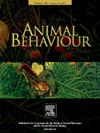In dogs, social stimuli overshadow nonsocial stimuli and stronger attachment correlates with responses to the latter
IF 2.3
2区 生物学
Q2 BEHAVIORAL SCIENCES
引用次数: 0
Abstract
The emotional reactivity hypothesis predicts that reduced fear and aggression in domesticated animals improves their social cognitive abilities towards humans. However, no studies in dogs, Canis familiaris, have shown that individual temperament is associated with higher social cognitive abilities, such as response to human pointing. In this study, we first trained dogs to learn correct responses in a two-choice task using a compound stimulus consisting of social (human pointing) and nonsocial stimuli (printed figures on paper) as cues. Social and nonsocial stimuli were presented alone to examine whether the social stimulus overshadowed the nonsocial stimulus. We also examined the correlation between temperament scores (based on the Canine Behavioral Assessment & Research Questionnaire, C-BARQ) and task performance. The results showed that social stimuli overshadowed nonsocial stimuli in most dogs, indicating that dogs used social stimuli from humans more frequently than nonsocial stimuli. Strong positive correlations were observed between attachment scores from the C-BARQ and correct response rates to nonsocial stimuli, but there was no correlation between aggression/fear and correct response rates to social stimuli. We considered that positive correlations between attachment scores and correct response rates to nonsocial stimuli indicate the degree of individual attentiveness to various environmental stimuli, and that responses to human pointing are likely to be reinforced from an early age. In addition, individual fear and aggression and social cognitive abilities can vary separately.
求助全文
约1分钟内获得全文
求助全文
来源期刊

Animal Behaviour
生物-动物学
CiteScore
4.60
自引率
8.00%
发文量
236
审稿时长
10.2 weeks
期刊介绍:
Growing interest in behavioural biology and the international reputation of Animal Behaviour prompted an expansion to monthly publication in 1989. Animal Behaviour continues to be the journal of choice for biologists, ethologists, psychologists, physiologists, and veterinarians with an interest in the subject.
 求助内容:
求助内容: 应助结果提醒方式:
应助结果提醒方式:


